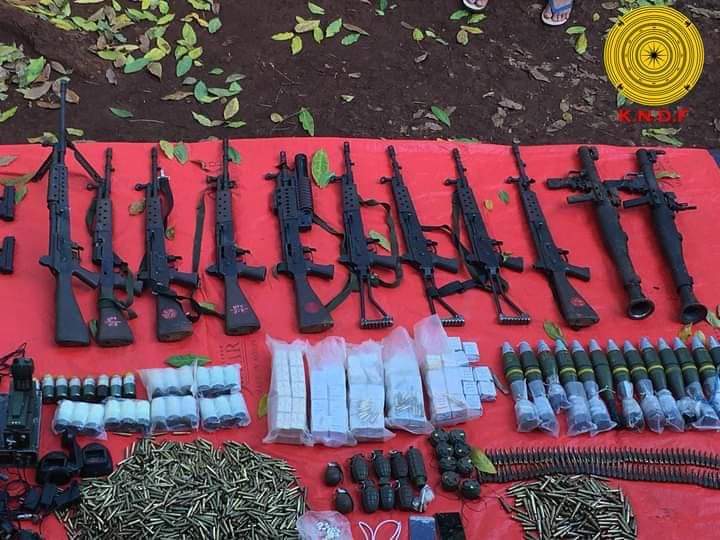Myanmar’s military regime is mounting large-scale attacks in southeast Myanmar’s Kayah State, but is also suffering heavy casualties, according to Karenni resistance forces and military analysts.
Even as the devastating Cyclone Mocha was making landfall in Rakhine State on May 14, junta troops attacked Dawh Hlar Khu Village in the east of Demoso Township, some ten miles from the Kayah State capital Loikaw, and clashed with resistance groups including the Karenni Nationalities Defense Force (KNDF), the Karenni Army (KA) and local People’s Defense Forces (PDF).
The fierce fighting lasted for nine days. Around 40 regime soldiers, including a captain and two lieutenants, and eight Karenni resistance fighters were killed in the clashes, said the KNDF on May 25. The Irrawaddy could not verify the casualties of both sides independently.
Some 14 firearms including a pistol, two rocket-propelled launchers and ammunition were seized by the KNDF.
Fresh clashes broke out on May 27 after junta troops launched assaults in Moebye Town on the border of Kayah and southern Shan states and in Konethar, Kayanthar and Saungkan villages in Loikaw Township.
Regime aircraft carried out at least eight airstrikes during the Moebye fighting. A three-year-old was killed, four other civilians wounded and dozens of houses were damaged, according to Moebye PDF.
On May 28, a junta jet dropped two bombs on refugee camps in the west of Moebye at around 4.30am, injuring four civilians and destroying three houses.
The Karenni Revolution Union said that on May 29 four of its medics, two men and two women, were killed while evacuating the wounded in the May 27 clashes.
Three fighters from KNDF Battalion 2 died in the fighting in Konethar Village in Loikaw, according to the KNDF.
KA spokesman Khu Nye Reh said more junta troops were killed in the fighting than Karenni resistance fighters.
“We can tell that they suffer heavy casualties in the fighting. What we understand is that some of them have little combat experience. Some fled during the fighting in the Dawtamagyi neighborhood in March. They said that they had only been in the military for less than a year or only a month in some cases. We also have the advantage of local knowledge, as some junta battalions are not familiar with the terrain and weather here. We can guess which routes they will use.”
Junta troops have even attempted close-quarter combat in an attempt to seize resistance bases in the east of Demoso Township, said the KA’s Khu Nye Reh.

Since then regime forces have retreated a mile, but junta troops and resistance fighters remain deployed in the neighborhood known as Seven-Tier Lake and military tensions are running high. There are daily skirmishes across Kayah State, said the KA’s spokesperson.
“There are clashes every day. Junta troops fire artillery and regime aircraft fly every day. There are skirmishes and sneak attacks on junta troops every day from the east of Demoso to the east of Hpruso and in the north of Bawlakhe. We also carry out daily ambushes with mines,” said Khu Nye Reh.
But for all the Myanmar military’s large-scale attacks in Kayah since February, regime forces have failed to make any serious impact on the resistance, noted a military analyst.
The junta has brought in significant reinforcements from northern Shan State to launch large-scale operations in Kayah, but it is far from gaining an upper hand over the Karenni resistance forces.
“The regime is using around 40 battalions. But we can see that is not achieving good results,” said the military analyst.
Despite all the reinforcements, junta soldiers are still outnumbered by Karenni resistance forces, added the analyst.
The KNDF, which is the strongest resistance group in Kayah, has 21 battalions. And there are also PDF battalions in every township. There are over 20,000 resistance fighters armed with automatic weapons fighting the regime across Kayah, said the military analyst.
However, more locals have been displaced by the fighting. The number has increased by 50,000 to 250,000 over the past few months, according to the Karenni Human Rights Organization (KHRO).
Aid provided by United Nations (UN) agencies and international organizations only reaches towns controlled by the regime and is not reaching refugees sheltering in the forest, said Ko Banyar, the director of the KHRO.
“There are already restrictions [imposed by the regime] on deliveries of food. Tight security checks outside Loikaw, which is the main route for transportation of commodities into Kayah, also makes delivering food difficult. UN agencies and international organizations only work in towns. They have only supplied Pekon and Loikaw towns, and they could not reach Hpruso, Demoso, Mese and Hpasawng where there are many displaced people. So we have to help them by ourselves,” he said.
With military tensions escalating in Kayah State, more civilians are bound to be displaced in the months to come. As the conflict zone widens, local resistance forces may struggle to obtain more weapons and ammunition.

















